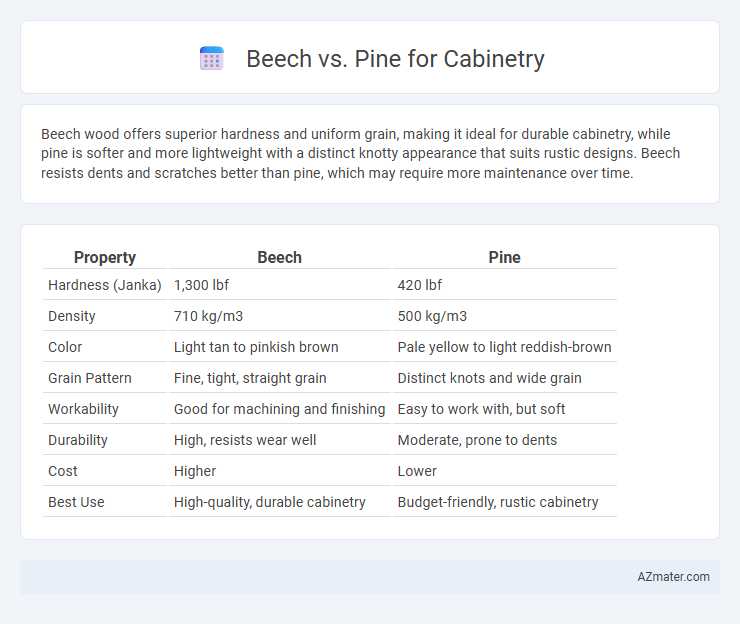Beech wood offers superior hardness and uniform grain, making it ideal for durable cabinetry, while pine is softer and more lightweight with a distinct knotty appearance that suits rustic designs. Beech resists dents and scratches better than pine, which may require more maintenance over time.
Table of Comparison
| Property | Beech | Pine |
|---|---|---|
| Hardness (Janka) | 1,300 lbf | 420 lbf |
| Density | 710 kg/m3 | 500 kg/m3 |
| Color | Light tan to pinkish brown | Pale yellow to light reddish-brown |
| Grain Pattern | Fine, tight, straight grain | Distinct knots and wide grain |
| Workability | Good for machining and finishing | Easy to work with, but soft |
| Durability | High, resists wear well | Moderate, prone to dents |
| Cost | Higher | Lower |
| Best Use | High-quality, durable cabinetry | Budget-friendly, rustic cabinetry |
Introduction to Beech and Pine for Cabinetry
Beech wood, known for its fine grain and pale cream color, offers superior strength and durability ideal for high-quality cabinetry. Pine, a softer wood with a distinctive knotty appearance and warm yellowish hue, provides an affordable and easily workable option for rustic-style cabinets. Selecting between beech and pine depends on desired aesthetics, durability requirements, and budget constraints in cabinetry projects.
Wood Characteristics: Beech vs Pine
Beech wood features a hard, dense grain that provides excellent durability and a smooth finish, ideal for cabinetry requiring strength and resistance to wear. Pine is softer with a more pronounced grain pattern, making it easier to work with but more prone to dents and scratches over time. Beech's pale cream color offers a uniform appearance, while pine's warm, knotty texture adds rustic charm but can require more maintenance to preserve its look.
Appearance and Grain Patterns
Beech wood features a smooth, consistent grain pattern with light, creamy tones that provide a clean and uniform appearance ideal for modern cabinetry. Pine offers a more rustic look with prominent knots and a varied grain, showcasing warm yellow to amber hues that add character and a natural feel. Both woods allow for staining and finishing, but beech's fine grain results in a sleek finish, whereas pine emphasizes texture and natural imperfections.
Durability and Strength Comparison
Beech wood offers superior hardness and resistance to wear, making it highly durable for cabinetry subjected to frequent use. Pine is softer and more prone to dents and scratches, reducing its long-term durability compared to beech. The dense grain structure of beech provides greater strength, supporting heavier loads without warping or splitting, unlike pine which is more susceptible to damage under stress.
Workability and Ease of Crafting
Beech wood offers excellent workability with its fine, tight grain and smooth texture, making it ideal for detailed cabinetry and intricate joinery. Pine is softer and easier to cut but can dent and scratch more readily, which may require extra care during crafting and finishing. Both woods accept stains and paints well, but beech provides a more durable surface for long-lasting cabinetry projects.
Cost Differences: Beech vs Pine
Beech wood typically costs more than pine due to its density and fine grain, which offers greater durability and a smoother finish for cabinetry. Pine is generally more affordable, making it a popular choice for budget-conscious projects but it is softer and more prone to dents and scratches. The higher price of beech reflects its superior hardness and longevity, justifying the investment for long-lasting kitchen cabinets.
Finishing Options and Stain Compatibility
Beech wood offers a smooth, fine grain that readily accepts a variety of finishes, making it ideal for staining and achieving a consistent color tone in cabinetry. Pine features a more pronounced grain with natural knots, which can absorb stain unevenly, resulting in a rustic or distressed appearance preferred in country-style designs. Both woods are compatible with oil-based and water-based stains, but Beech's uniform texture allows for a more professional, sleek finish, while Pine's unique grain pattern enhances character in cabinetry projects.
Environmental Impact and Sustainability
Beech wood, sourced primarily from European forests with sustainable management certifications such as FSC, offers a renewable option for cabinetry due to its rapid growth and high density, which extends the lifespan of cabinetry products. Pine, commonly harvested from managed North American forests, features faster growth rates and lower carbon storage, making it more renewable but less durable compared to beech, resulting in potentially higher replacement rates over time. Both woods contribute to sustainable forestry when sourced responsibly, but pine's lower environmental footprint in harvesting and processing often makes it preferable for eco-conscious cabinetry choices.
Best Applications for Each Wood Type in Cabinetry
Beech wood, known for its hardness and fine grain, is ideal for cabinetry requiring durability and a smooth finish, making it perfect for kitchen cabinets and furniture that endure daily use. Pine, a softer wood with distinctive knots and a lighter color, is best suited for rustic or country-style cabinets, offering affordability and ease of customization in spaces where a warm, natural look is desired. Both woods provide unique benefits: Beech excels in high-traffic areas due to its strength, while Pine is suitable for decorative cabinetry and budget-friendly projects.
Choosing the Right Wood: Beech or Pine for Your Cabinets
Beech offers a tight grain and high durability, making it ideal for cabinets that require strength and a smooth finish. Pine is softer with a distinct rustic look, suitable for budget-friendly cabinetry with a warm, natural appearance. Choose Beech for long-lasting, fine-grained cabinets and Pine for cost-effective, charming styles that highlight wood knots and textures.

Infographic: Beech vs Pine for Cabinetry
 azmater.com
azmater.com